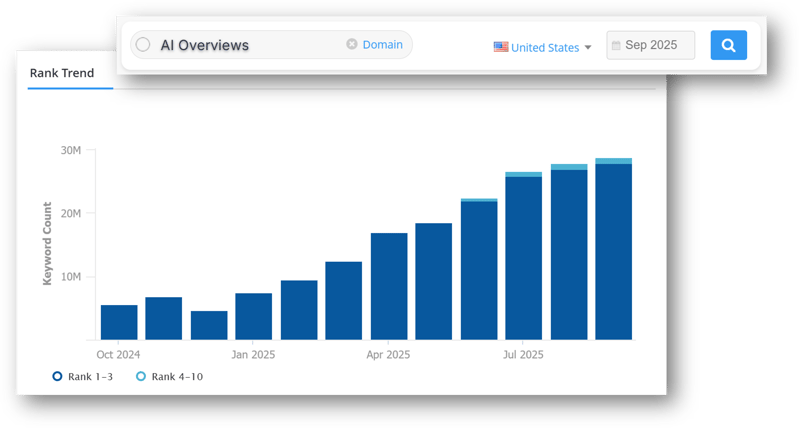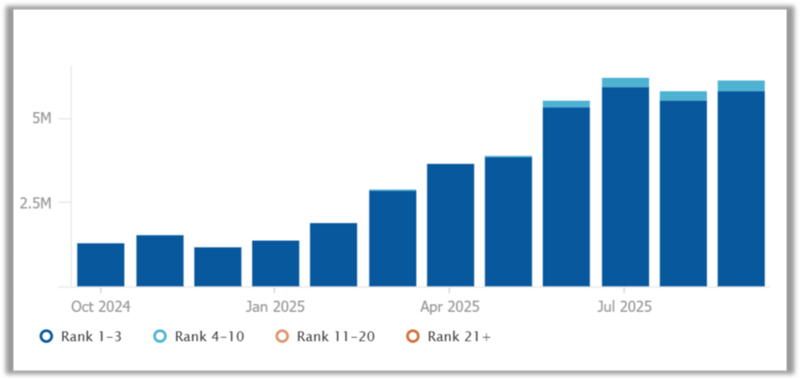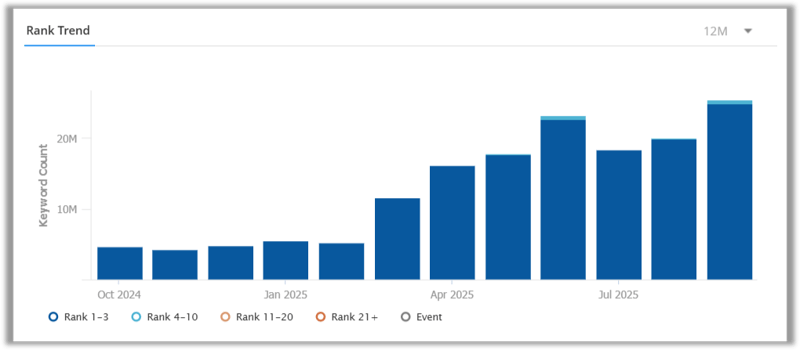seoClarity Research Study
Impact of Google’s AI Overviews: SEO Research Study
By Mark Traphagen, Vice President of Product Marketing and Training
Last Updated: 10/23/25

By Mark Traphagen, Vice President of Product Marketing and Training
Last Updated: 10/23/25

AI Overviews (AIOs), a feature that offers a Generative AI summary of information above organic search results for certain queries, have had a volatile rollout starting in May 2024.
Here's an AIO example:

To understand the impact of Google's AI Overviews on organic keyword rankings, we have conducted an in-depth analysis based on the data from our extensive Research Grid dataset.

Based on our substantial Research Grid dataset, the prevalence AI Overviews on desktop searches in the U.S. has increased significantly over the past year, aside from a significant drop in December 2024.
They now appear for 30% of U.S. desktop keywords as of September 2025. For reference, six months prior in March 2025, AIOs appeared for just 10% of keywords.
This sharp rise underscores Google’s accelerating integration of generative AI into search, signaling a major shift in how visibility, traffic, and user engagement will be distributed across the SERP landscape.
Between Sept 2024 to September 2025, the prevalence of AIOs on desktop searches in the UK has also increased substantially at roughly 536.6%.

We will continue tracking AIO and updating these figures as we gather more data.
According to seoClarity’s Research Grid, the presence of AI Overviews for mobile US keywords has surged nearly 475% year-over-year (Sept 2024 to Sept 2025), marking a dramatic expansion—though still slightly trailing desktop visibility.
While there was a brief dip in July 2025, AIO prevalence has since rebounded strongly, reflecting the continued rollout and testing of generative AI experiences across mobile search results.
 Frequency of AIOs for mobile U.S. searches.
Frequency of AIOs for mobile U.S. searches.
We've built a complete workflow within seoClarity that enables clients to take full advantage of this data to see the impact of AIO on the traffic and to measure the CTR impact this could have.

Our analysis of 432,000 keywords found that 97% of AI Overviews cite at least one source from the top 20 organic results, underscoring how closely AIO visibility aligns with traditional SEO rankings. On average, each AIO includes five URLs from these top results, often blending insights from multiple high-performing pages.
While higher rankings strongly correlate with inclusion—Position 1 pages appear in AIOs more than half the time—ranking well is a signal, not a guarantee.
This marks a substantial change from what we saw in Google's Search Generative Experience (SGE) and the early days of AIO where there was very little correlation between ranking sites and what appeared in AIO results.
Read our full study on the overlap between AI Overviews and organic rankings to explore the complete data and strategic implications.

Transactional: Initially, AI Overviews did not appear for most transactional head terms. However, the number of AIOs in transactional keywords has gradually risen to 12.54% as of September 2025.
Informational: AI Overviews most commonly appear for queries with informational intent. However, the prevalence of AIOs for informational keywords is slowly dropping in correspondence with the rise of transactional appearances.
Initially, AI Overviews did not appear for local queries, despite previously appearing for local results in SGE.
However, AIOs had begun appearing for a meager 0.14% of local keywords in March 2025. Now, in September 2025, this number has fallen to just 0.01%.
Recommended Reading: AI Search Optimizations You Can Do TODAY
In a surprising discovery, our data science team found that the average text length of AI Overviews has declined by 70% — from approximately 5,300 characters in July to just 1,600 characters in August.
Our latest analysis reveals a striking trend: the average length of AI Overviews has dropped by roughly 70%, shrinking from around 5,300 characters in July to just 1,600 in August.
It’s important to note that the frequency of AIO appearances hasn’t changed significantly—what’s shifting is their depth and detail.

From an SEO standpoint, this shift reinforces the need to optimize for visibility beyond AIOs. We suggest continuing to build strong organic relevance, monitor how your brand surfaces in AI Mode, and prioritize authoritative mentions and citations as the battle for limited AI-driven exposure intensifies.
As of August 15, 2024, Google rolled out AI Overviews to non-logged-in users. Since then, we have been able to track AIOs across all the keywords within seoClarity's Research Grid database.
The insights presented here are derived from our comprehensive U.S. dataset of 500+ million keywords, enabling us to measure AIO prevalence, changes in appearance rates, and evolving SERP patterns with statistical confidence.
We will continue to provide updated data and insights as AI Overviews evolve.
To monitor the impact of AI overviews on your rankings and traffic, we’ve outlined several ways to do so using the seoClarity platform – including using our AI Overviews filter in SERP Features which tracks AIO summaries generated as a "Top Insights" panel.
In addition, clients now have the ability to:
Not currently an seoClarity client? Learn more about how our platform can help you monitor and strategize for AIO by scheduling a quick demo.
 About the Author: Mark Traphagen
About the Author: Mark TraphagenMark Traphagen is Vice President of Product Marketing and Training for seoClarity. His previous careers as a salesman and then a teacher were excellent preparations for what he does now. Mark's deep dive into online marketing began about 14 years ago when he was tasked with turning around a failing independent bookstore. He took the store online and developed practices of content marketing, influencer relationships, exceptional customer service, and community building that brought the store to profitability in two years. Since that time he has dedicated himself to learning what really works for online business success. He is a sought after speaker at conferences such as PubCon, State of Search, and SMX, and a featured writer for major online publications such as the Moz Blog, Search Engine Land, Marketing Land, and a VIP Columnist for Search Engine Journal.